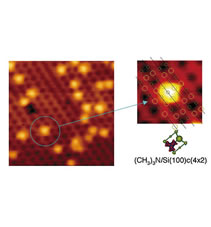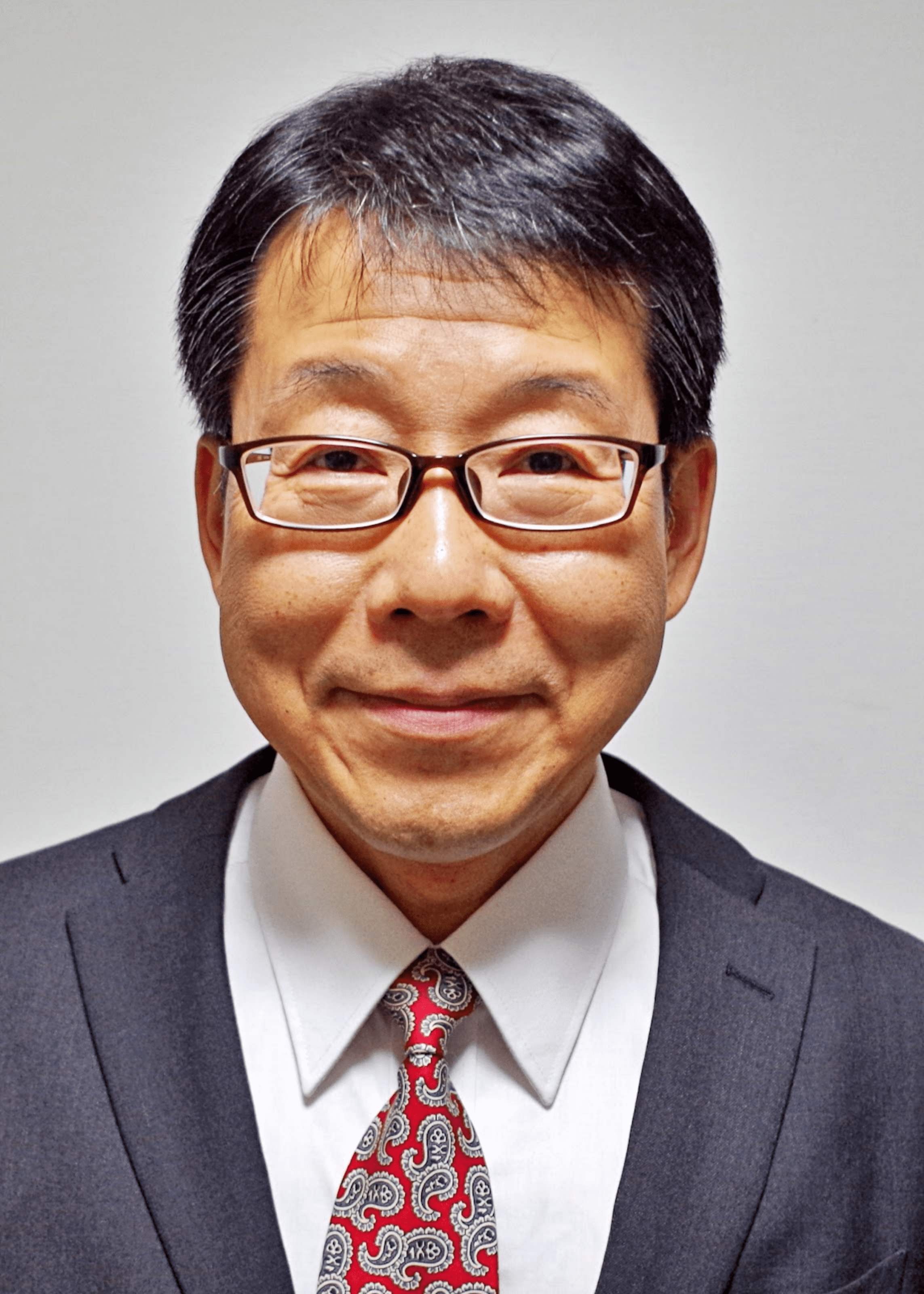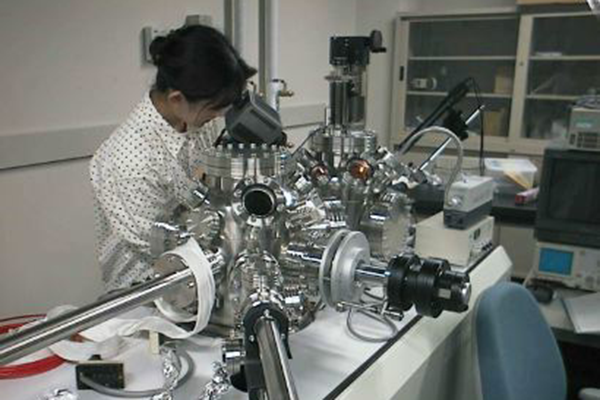FUNCTIONAL PROPERTIES
JUN YOSHINOBU LAB.
INTRODUCTION OF LABORATORY
Solid surfaces are intriguing objects; novel structures and electronic properties emerge as a result of symmetry breaking of bulk. In addition, a solid surface plays an important role as a “low dimensional reaction field”, on which we can supply atoms/ molecules and manipulate them deliberately. In order to fabricate atomically-controlled surface materials, the dynamical behavior of atoms and molecules on surfaces should be understood. These subjects are closely related to the basics of catalysis, semiconductor fabrication, organic devices, solar cells etc. In addition, the concepts in surface chemistry are very useful to understand elementary reactions in environmental and cosmic chemistry. In order to investigate structures, reactions and electronic properties of atoms and molecules on surfaces, we have utilized surface vibrational spectroscopy, photoelectron spectroscopy and scanning tunneling microscopy. Synchrotron radiation (KEK-PF, SPring8 etc.) is also used to study electronic structure of surface and interface.

80KのS(i 100)c(4×2)表面のダウンダイマー原子に選択的に結合したトリメチルアミン分子のSTM像とモデル図

MESSAGE
EXPERIMENTAL RESEARCH RESEMBLES MOUNTAINEERING.
In both “projects”, we must make a plan carefully and prepare instruments thoroughly. During the experiment, we have to keep the five sensens very keen; otherwise, we may miss important signs which nature shows. We often face difficulties, and depending on the situation we decide if we step forward, change direction or turn back. When various difficulties are overcome, nature shows impressive outcomes. Let’s enjoy this moment!
keyword
Photoelectron spectroscopy / Surface / Adsorption / Surface reaction / STM / Organic molecules / Silicon / Catalyst / Interface / Vibrational spectroscopy / Scanning tunneling microscope / Electrical conduction / Electron energy loss spectroscopy / Protium / Hydrogen / Chemical reaction / adsorption / HREELS / Liquid metal / Electronic state / X-ray emission spectroscopy / X-ray absorption spectroscopy / Infrared absorption spectroscopy / Reaction / Scanning tunneling microscope / IRAS / Yttrium / Palladium / Low temperature /Reflection infrared absorption spectroscopy / Surface spectroscopy / Edge / Atomic layer materials / Layered compounds / Carbon monoxide / Planetary environment / Mass spectrometry / Infrared spectroscopy / Rare events / Reaction kinetics / Molecular vibration / Photodetachment / Photophysical properties / Sum Frequency generation / Ultrashort pulse laser / Terahertz / Active site / Mobility / Organic FET / Support / Graphene / Platinum / Alloy / Operando spectroscopy / Field effect transistor / Spectroscopy / Synchrotron radiation / Oxide film / Surface cleaning / Oxidation / Clean surface / interface / first principles calculation / scanning tunneling microscopy / electron energy loss spectroscopy / organic molecule / surface / silicon / first principles calculation / surface diffusion / Pt surface /photoelectron / Si surface / conformation / intermolecular interaction / cyclohexene / 1,4 cyclohexadiene / step surface / Pt / dimer / surface diffusion / platinum surface / silicon surface / probe / amalgam / surface electrical conductivity / four-probe measurement / Organic thin film / Non-destructive / Local probe / Thin film / Dynamics / Interface structure / Electrode / Charge transfer / Semiconductor / Surface interface / Tunnel physical properties / STS / Monolayer film / Alkyl group / Molecule / CO / Infrared reflection and absorption spectroscopy / Scanning type tunneling spectroscopy / electron spectroscopy / crystal / amorphous / molecular evolution / ice / water / absorption / atomic hydrogen / Fermi level / metal-insulator transition / ethylene / diamond / radical beam / surface chemical reaction / adsorbed molecules / resonance tunneling
PROFILE : Professor Jun Yoshinobu
1984年 B. A. from Kyoto University
1986 M. S. from Kyoto University
1989 Dr. of Science from Kyoto University
1989 Postdoc: University of Pittsburgh
1991 Postdoc: RIKEN
1992 Researcher: RIKEN
1997 Associate Professor: ISSP, University of Tokyo
2007 Professor: ISSP, University of Tokyo
STUDENT VOICE : YUICHIRO SHIOZAWA
Prof. Yoshinobu has a warm personality. He enthusiastically guides each student in their research and helps them when they have any other problems. The laboratory has an open and free atmosphere. Students have come from a wide range of fields such as chemistry, physics, and engineering. Yoshinobu’s laboratory has various advanced surface analysis systems, and we are constantly conducting cutting-edge research by making full use of these instruments. Although each student has his or her own research theme, synchrotron radiation experiments are conducted in cooperation with other members in the laboratory.

SOLID STATE PHYSICS AND CHEMISTRY
The key to discovery is whether you notice what you see.






Jun Yoshinobu Lab.,
Department Of Advanced Materials Science,
Graduate School of Frontier Sciences,
The University of Tokyo
Kashiwanoha 5-1-5,
Kashiwa,Chiba 277-8561, Japan
+81-4-7136-3320
yoshinobu@issp.u-tokyo.ac.jp
The Goal of Applied Physics
The goal of Applied Physics is to develop a stage = “new material” that can manipulate undeveloped degrees of freedom, to explore unknown phenomena created from that stage and to bring out excellent functions, and to bring out its excellent functions. The purpose is to contribute to the development of human society by elucidating the mechanisms and developing application fields for these phenomena and functions.
AMS (Advanced Materials Science)
Department Office
AMS (Advanced Materials Science),
Graduate School of Frontier Sciences,
The University of Tokyo
Kashiwanoha 5-1-5, Kashiwa, Chiba 277-8561, Japan
Email : ams-office(at)ams.k.u-tokyo.ac.jp
Please change (at) to @.
